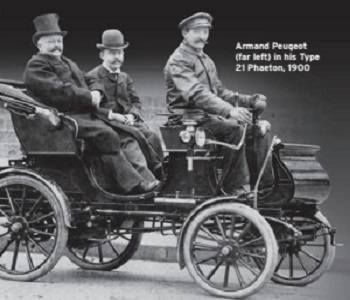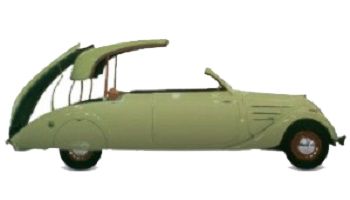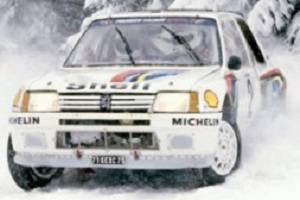Peugeot can rightfully claim to be among the oldest car manufacturers still in existence. In business long before the advent of the automobile, Peugeot has been making cars for more than a century. A giant of the industry, it remains one of the world’s largest producers, having absorbed several former rivals.

ARMAND PEUGEOT WAS born in 1849 in Hérimoncourt, eastern France. In 1865 he joined the family metalworking business, which made a range of tools and domestic goods. Armand was the main driving force behind the firm’s entry into bicycle manufacture in 1882.
He was intrigued by the prospect of developing a “horseless carriage,” and by the end of the decade he had built a batch of high-wheeled chassis intended for steam propulsion. He abandoned the project after meeting Gottlieb Daimler and Émile Levassor, who persuaded him instead to produce cars based on a Daimler concept. Peugeot’s vehicles were powered by gas-fueled internal combustion engines made by Panhard et Levassor under license from Daimler.
The first five cars emerged in 1891, although all were very different in design. Serious manufacture began in earnest two years later, with 24 cars being built. Peugeot was present at the birth of motor sport, taking part in the pioneering 1894 Paris-Rouen Rally. In 1895 Peugeot became the first marque to adopt pneumatic tires rather than solid rubber ones, along with sliding gear transmission.

Peugeot 402 Éclipse Décapotable
The convertible version of Peugeot’s 402 family car featured a power-operated retractable hardtop roof-the first of its kind in the world.
The business parted company with Daimler and began designing and building its own engines in-house from 1896. In the same year, Armand Peugeot broke free of family ties and set up his own company in Audincourt. By 1900 output was running at 500 cars per year, and three years later the firm was responsible for manufacturing half of all cars produced in France.
Yet as Armand Peugeot’s firm grew in stature, his personal wealth began to dwindle. In 1910 he joined forces with his cousin, Eugène, who still ran the family business. Peugeot’s Audincourt factory was modernized to aid efficiency, and in 1913 the company unveiled the tiny 6CV Type BP-1, designed by Ettore Bugatti.
The production of the popular Bébé, as the BP-1 was nicknamed, would exceed 3,000 by the time of its withdrawal in 1916. Rather larger than the Bébé was Peugeot’s 7.6-liter racer, which claimed the 1912 French Grand Prix and the following year’s Indianapolis 500 honors.
During World War I, Peugeot’s manufacturing facilities were largely given over to the production of armaments and military vehicles. The company emerged from the hostilities with bolstered coffers, enabling it to expand greatly during the 1920s, taking over both the Ballanger and De Dion marques in 1927.
A year later it introduced the Peugeot 201, then the cheapest conventional car on sale in France. The 201 was also the first Peugeot model to feature a zero in its model designation. The 1930s saw Peugeot struggle during the Depression, not helped by the fact that its rapid expansion had saddled it with a vast and incoherent model range and a multitude of inefficient factories. During the second half of the decade it showed great daring by adopting designer Jean Andreau’s aerodynamic outlines for the 202, 302, and 402 models.

Peugeot 205 Turbo
Ari Vatanen and his co-driver, Terry Harryman, are seen here in their Peugeot 205 Turbo 16 on their way to first place in the 1985 Swedish Rally. Their victory helped Peugeot win the manufacturers’ championship.
While the move was bold, it was not a commercial success: The French car-buying public proved resistant to their charms, and all three variations on the theme were slow sellers. As with all other French marques, Peugeot’s factories were taken over by the Nazis after France was occupied by German forces in 1940.
Postwar manufacture restarted in 1945, and three years later Peugeot’s first new model, the 203, entered production. Although it borrowed some of its running gear from pre-war models, the 203 had a roomy body that looked very much in tune with the times. The success of the 203 would be long-lived, with nearly 700,000 being made until the end of the model’s production in 1960.
An even bigger seller than the 203 was 1955’s handsome 403 sedan, styled by the Italian design company Pinin Farina (later called Pininfarina). This was followed in 1960 by the 404, which used a 1,618 cc version of the 403 engine tilted at 45 degrees. The 404 proved rugged enough to win the East African Safari Rally in four of the six competitions between 1963 and 1968.
More models followed, many of which were styled by Pininfarina, including the 504 of 1968-one of Peugeot’s most distinctive cars. Despite the success of its sedans, Peugeot was losing out in the market because its range lacked a small car.
The company addressed this with the 204, which, after a protracted gestation period, emerged in 1965. The 204 was the first Peugeot with front-wheel drive-soon to be a standard feature of the marque-and over 1.5 million 204s were made from 1965 to 1976.

In the late 1960s and early 1970s, Peugeot embarked on joint ventures with other marques, including Volvo and Renault. In 1974 the company acquired a substantial stake in its archrival Citroën, which became a 90 percent shareholding two years later. This effectively doubled Peugeot’s turnover and production capacity, but its expansionist aims were not yet satisfied, and in 1978 it also acquired Chrysler’s European subsidiaries.
The new parent company, Peugeot Socièté Anonyme (PSA), aimed to maintain separate identities for Peugeot and Citroën while sharing resources. While Citroën models subsequently lost some of their individuality, the Peugeot brand remained strong. In 1983 Peugeot scored a big hit with its 205 hatchback.
It used the 205 to reestablish itself as a force in rallying, taking the World Rally Championship title in 1985 and 1986, and the 1992 World Sports Car Championship. More recently, the marque has also returned to the race track, taking the 2009 Le Mans 24-hour title with its diesel-engined 908 HDi FAP.
Future Peugeot plans include developing diesel-hybrid road cars and expanding further into the Chinese and Latin American markets. The Peugeot family still retains a quarter share of the business, itself something of an achievement in such a fickle industry. Despite facing many storms, Peugeot has managed to sustain its position as one of the world’s foremost marques.